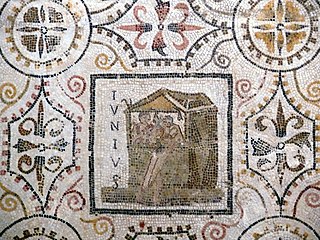
The Ides of March is the day on the Roman calendar marked as the Idus, roughly the midpoint of a month, of Martius, corresponding to 15 March on the Gregorian calendar. It was marked by several major religious observances. In 44 BC, it became notorious as the date of the assassination of Julius Caesar, which made the Ides of March a turning point in Roman history.

A religious festival is a time of special importance marked by adherents to that religion. Religious festivals are commonly celebrated on recurring cycles in a calendar year or lunar calendar. The science of religious rites and festivals is known as heortology.

In ancient Roman religion, Mens, also known as Mens Bona, was the personification of thought, consciousness and the mind, and also of "right-thinking". The founding (dies natalis) of her temple in Rome was celebrated on June 8. A temple on the Capitoline Hill in Rome was vowed to Mens in 217 BC on advice from the Sibylline Books, after the defeat of Lake Trasimene, and was dedicated in 215 BC.
In ancient Roman religion, Tempestas is a goddess of storms or sudden weather. As with certain other nature and weather deities, the plural form Tempestates is common. Cicero, in discussing whether natural phenomena such as rainbows and clouds should be regarded as divine, notes that the Tempestates had been consecrated as deities by the Roman people.

In the ancient Roman calendar, Quintilis or Quinctilis was the month following Junius (June) and preceding Sextilis (August). Quintilis is Latin for "fifth": it was the fifth month in the earliest calendar attributed to Romulus, which began with Martius and had 10 months. After the calendar reform that produced a 12-month year, Quintilis became the seventh month, but retained its name. In 45 BC, Julius Caesar instituted a new calendar that corrected astronomical discrepancies in the old. After his death in 44 BC, the month of Quintilis, his birth month, was renamed Julius in his honor, hence July.

Festivals in ancient Rome were a very important part in Roman religious life during both the Republican and Imperial eras, and one of the primary features of the Roman calendar. Feriae were either public (publicae) or private (privatae). State holidays were celebrated by the Roman people and received public funding. Games (ludi), such as the Ludi Apollinares, were not technically feriae, but the days on which they were celebrated were dies festi, holidays in the modern sense of days off work. Although feriae were paid for by the state, ludi were often funded by wealthy individuals. Feriae privatae were holidays celebrated in honor of private individuals or by families. This article deals only with public holidays, including rites celebrated by the state priests of Rome at temples, as well as celebrations by neighborhoods, families, and friends held simultaneously throughout Rome.

The Floralia was a festival in ancient Roman religious practice in honor of the goddess Flora, held on 27 April during the Republican era, or 28 April in the Julian calendar. The festival included Ludi Florae, the "Games of Flora", which lasted for six days under the empire.

In Roman religion, Terminus was the god who protected boundary markers; his name was the Latin word for such a marker. Sacrifices were performed to sanctify each boundary stone, and landowners celebrated a festival called the "Terminalia" in Terminus' honor each year on February 23. The Temple of Jupiter Optimus Maximus on the Capitoline Hill was thought to have been built over a shrine to Terminus, and he was occasionally identified as an aspect of Jupiter under the name "Jupiter Terminalis".

The Parilia or Palilia was an ancient Roman festival of rural character performed annually on 21 April, aimed at cleansing both sheep and shepherd. It was carried out in acknowledgment to the Roman deity Pales, a deity of uncertain gender who was a patron of shepherds and sheep.

In ancient Roman religion and mythology, Tellus Mater or Terra Mater is the personification of the Earth. Although Tellus and Terra are hardly distinguishable during the Imperial era, Tellus was the name of the original earth goddess in the religious practices of the Republic or earlier. The scholar Varro (1st century BC) lists Tellus as one of the di selecti, the twenty principal gods of Rome, and one of the twelve agricultural deities. She is regularly associated with Ceres in rituals pertaining to the earth and agricultural fertility.

Februarius, fully Mensis Februarius, was the shortest month of the Roman calendar from which the Julian and Gregorian month of February derived. It was eventually placed second in order, preceded by Ianuarius and followed by Martius. In the oldest Roman calendar, which the Romans believed to have been instituted by their legendary founder Romulus, March was the first month, and the calendar year had only ten months in all. Ianuarius and Februarius were supposed to have been added by Numa Pompilius, the second king of Rome, originally at the end of the year. It is unclear when the Romans reset the course of the year so that January and February came first.

In ancient Roman religion and mythology, Mars is the god of war and also an agricultural guardian, a combination characteristic of early Rome. He is the son of Jupiter and Juno, and was pre-eminent among the Roman army's military gods. Most of his festivals were held in March, the month named for him, and in October, the months which traditionally began and ended the season for both military campaigning and farming.
In ancient Roman religion, the Fordicidia was a festival of fertility, held on the Ides of April, that pertained to farming and animal husbandry. It involved the sacrifice of a pregnant cow to Tellus, the ancient Roman goddess of the Earth, in proximity to the festival of Ceres (Cerealia) on April 19.
The Vitulatio was an annual thanksgiving celebrated in ancient Rome on July 8, the day after the Nonae Caprotinae and following the Poplifugia on July 5. The Poplifugia is a lesser-known festival that was of obscure origin even for the Romans themselves; Macrobius says that it marked a Roman retreat from the Etruscans at Fidenae during the Gallic invasion, and that the Vitulatio commemorated their comeback victory. It was a dies religiosus, a day of religious prohibition when people were to refrain from undertaking any activity other than attending to basic necessities.

The Amburbium was an ancient Roman festival for purifying the city; that is, a lustration (lustratio urbis). It took the form of a procession, perhaps along the old Servian Wall, though the length of 10 kilometers would seem impractical to circumambulate. If it was a distinct festival held annually, the most likely month is February, but no date is recorded and the ritual may have been performed as a "crisis rite" when needed.

Martius or mensis Martius ("March") was the first month of the ancient Roman year until possibly as late as 153 BC. After that time, it was the third month, following Februarius (February) and preceding Aprilis (April). Martius was one of the few Roman months named for a deity, Mars, who was regarded as an ancestor of the Roman people through his sons Romulus and Remus.

Aprilis or mensis Aprilis (April) was the second month of the ancient Roman calendar, following Martius (March) and preceding Maius (May). On the oldest Roman calendar that had begun with March, Aprilis was the second of ten months in the year. April had 29 days on calendars of the Roman Republic, with a day added to the month during the reform in the mid-40s BC that produced the Julian calendar.

On the ancient Roman calendar, mensis Iunius or Iunius, also Junius (June), was the fourth month, following Maius (May). In the oldest calendar attributed by the Romans to Romulus, Iunius was the fourth month in a ten-month year that began with March (Martius, "Mars' month"). The month following June was thus called Quinctilis or Quintilis, the "fifth" month. Iunius had 29 days until a day was added during the Julian reform of the calendar in the mid-40s BC. The month that followed Iunius was renamed Iulius (July) in honour of Julius Caesar.
October or mensis October was the eighth of ten months on the oldest Roman calendar. It had 31 days. October followed September and preceded November. After the calendar reform that resulted in a 12-month year, October became the tenth month, but retained its numerical name, as did the other months from September to December.
November or mensis November was originally the ninth of ten months on the Roman calendar, following October and preceding December. It had 29 days. In the reform that resulted in a 12-month year, November became the eleventh month, but retained its name, as did the other months from September through December. A day was added to November during the Julian calendar reform in the mid-40s BC.
















